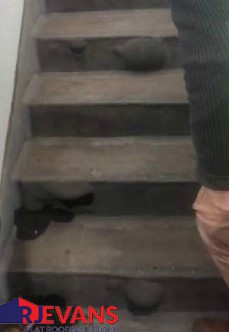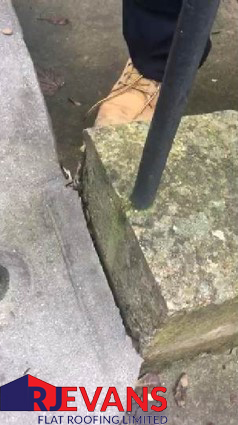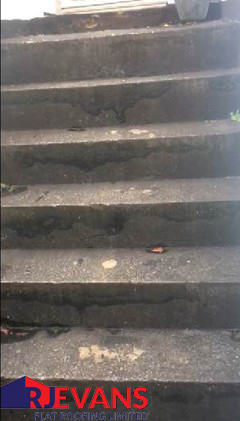I agree Our site saves small pieces of text information (cookies) on your device in order to deliver better content and for statistical purposes. You can disable the usage of cookies by changing the settings of your browser. By browsing our website without changing the browser settings you grant us permission to store that information on your device.

Asphalt is the best material to use for waterproofing steps. And if installed correctly will outperform other step waterproofing systems. However due to being at the end of their service life or poor workmanship asphalt steps can develop problems.
Cracks and splits can be created in asphalt steps. The reason for this is moisture gets trapped underneath the asphalt and it attempts to escape by pushing up onto the asphalt create a bump. Eventually this bump will give way and a crack or split will occur.
Blows are like big bubbles under the surface of the asphalt. It is common to see these occur on asphalt risers. The reason for these occurring is down to water bring trapped behind the substrate. During the summer months, the moisture tries to outgas and this is how the big bubbles are formed. The way to fix this problem is cut the blow out of the asphalt steps. Then to dry out the substrate, re-prime it and then re asphalt the area.
Brickwork pulling away from the mastic asphalt can occur due to movement over the course of the year. The way to prevent this happening is to cut a chase into the brickwork, apply a primer and to put an asphalt upstand.

Impact cracks occur when a heavy object is dropped onto the asphalt surface. The probability of an impact crack occurring is more likely in cold weather.
This is a common problem with asphalt steps which are south facing. The sun heats the asphalt and draws all of the bitumen to the surface. This is why you see older asphalt lose its colour as over the years the bitumen which gives the darker colour is drawn out. Intense sun can cause asphalt to develop a worn grey look much earlier than should be the case.
Another problem is the exposure from the sun causes the asphalt to slump. And the continuous cycle of warm and cold weather which is typical of the UK can cause cracks to developed. Obviously cracks in the steps waterproofing system are no good as water ingress will occur.
Applying solar protective paint is the best way to minimise the effect the sun has on the asphalt. This does not completely eliminate the sun affect the asphalt but it does vastly reduce the damage received which greatly lengthens the asphalts service life.
Some products are not suitable for heavy foot traffic. The top coat of mastic asphalt steps contains paving and grit. This is to withstand the foot traffic they will incur and to provide traction. If your steps have not used the correct waterproofing product the solution is to clean down the steps. Then to re-apply the correct waterproofing product. This can be either mastic asphalt or a liquid waterproofing product. The key here is to ensure the coating is suitable for foot traffic and provides traction.

If the upstands are not high enough on a set of asphalt steps it is very likely the steps will suffer from water ingress. To fix this problem a chase needs to be cut into the wall. A primer applied and an upstand of at least 150mm used. Then the upstand must be finished with a termination bar or pointed with sand and cement.
A lot of steps will have upstand which are not cut into the wall. And these upstands will be finished with just a bead of silicon. This is not good enough and does not protect against water ingress. A chase needs to be cut into the wall, primed and then an upstand of at least 150mm as mentioned above.
Slumping does not just occur due to exposure to the sun. A lot of the time slumping is caused by the gas torch of a poor asphalt spreader. They will use a gas torch to warm the upstands while completing the filler coat. All this does is burn the new asphalt and causes slumping in most cases. This problem is caused by pure laziness and has a detrimental effect on the lifespan of the steps.
As you can see there are three common problems which can develop with asphalt steps. Sun Exposure, Water Ingress and Impact Damage. All of these problems are more likely in the event of poor workmanship or if the steps are towards the end of their working life. Thankfully all of these problems can be put right by skilled craftsmen as mastic asphalt can easily be repaired.
To learn more about asphalt, waterproofing and roofing you can find more blog posts by clicking here.
If you have any problems with a set of asphalt steps and have any question or would like to get a quotation. You can get in touch with us through this website or call us on 01277 375 511. One of our friendly asphalt surveyors will be happy to help.